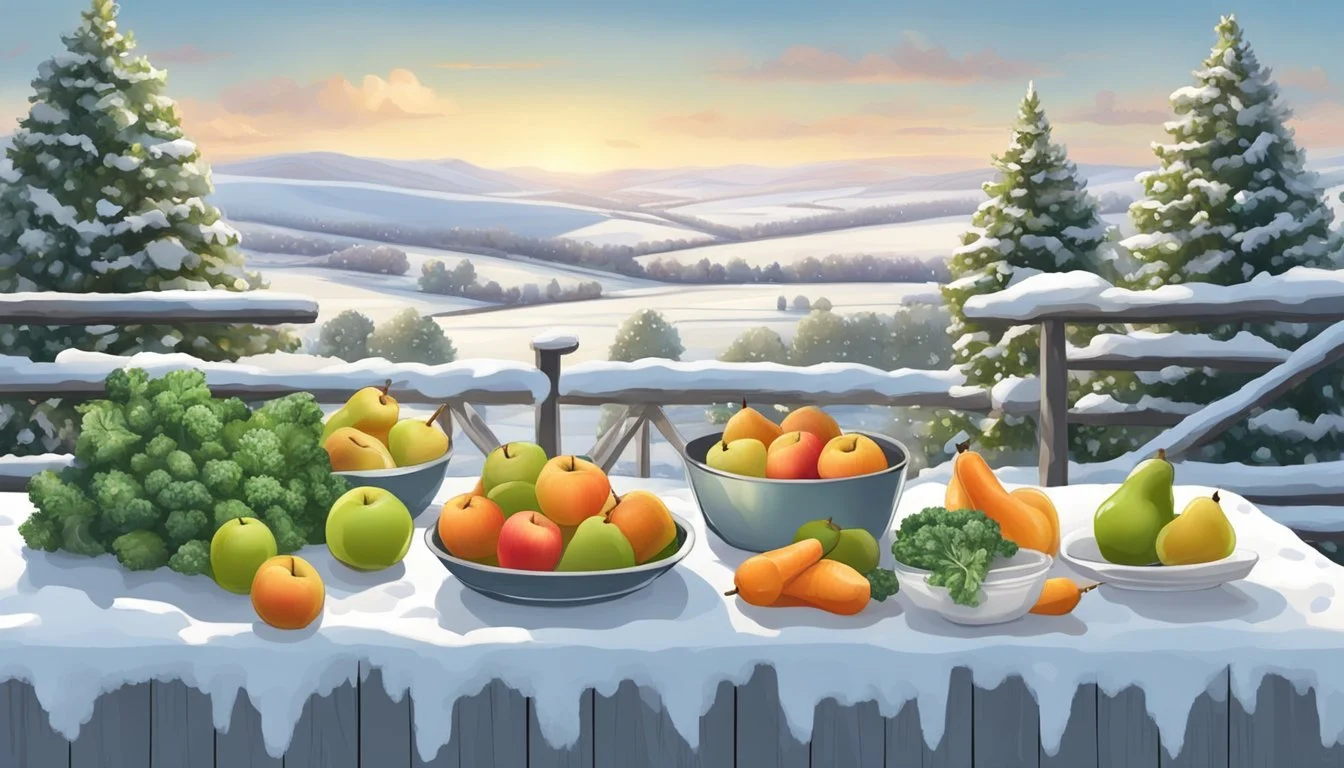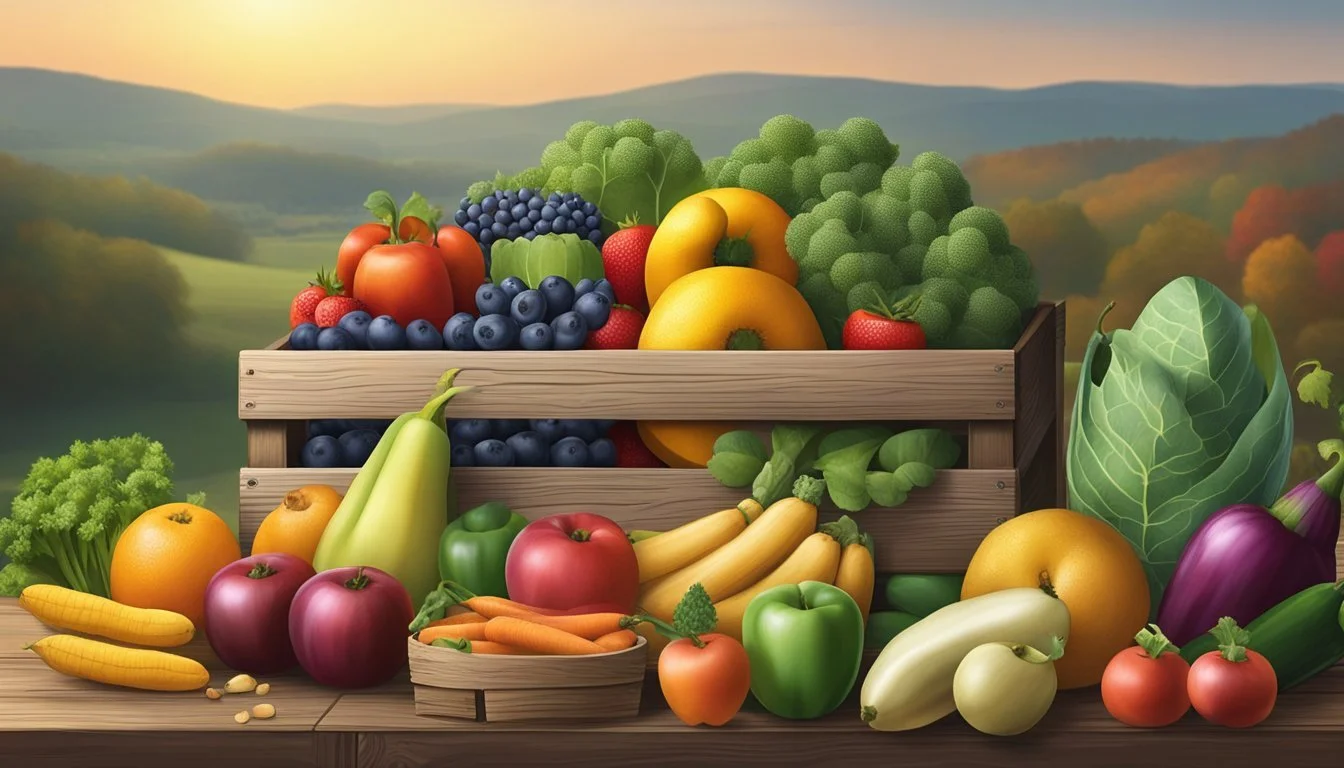Tennessee Seasonal Fruit & Vegetables in January
Your Winter Produce Guide
This Article is Part of our Tennessee Seasonal Fruit & Veg Calendar
Understanding the rhythm of Tennessee's harvest seasons allows for an appreciation of the richness and diversity of produce available throughout the year. In the heart of winter, January presents a unique array of fruits and vegetables that can withstand the cooler climate. Despite the chill, Tennessee's farms continue to yield produce that not only tolerates but thrives in the season's conditions.
Cool-season crops dominate the January landscape. Root vegetables such as sweet potatoes, turnips, and radishes continue to be harvested, offering robust flavors and hearty textures fit for winter meals. Leafy greens like kale (What wine goes well with kale?) and spinach are also in abundance, providing nutritious options for those seeking fresh produce. These resilient varieties reflect Tennessee's agricultural adaptability, ensuring a fresh selection even during the colder months.
Fruits are more limited during this time, as many varieties reach their peak in other seasons. However, apples, which are harvested in the fall, are still widely available due to their long shelf-life when properly stored. They remain a sweet and crunchy reminder of the previous season's bounty and are a testament to the region's ability to offer fresh fruit beyond the harvest.
Overview of Tennessee's Seasonal Climates and Its Impact on Agriculture
Tennessee's agriculture is significantly influenced by its diverse seasonal climates and categorized hardiness zones. This variation affects what fruits and vegetables can be grown and when.
Understanding Tennessee's Diverse Climate
Tennessee experiences a predominantly humid subtropical climate with the exception of the higher elevations, which fall under the Oceanic/Highland climate type. Summers across the state are hot, with temperatures that can escalate plant growth, but they are also paired with increased humidity and rainfall levels. In contrast, winters are generally mild to cold. This dynamic climate entails a mix of challenges and benefits for agriculture, as temperature and precipitation shifts can dictate the success or failure of crop yields.
Agriculture Hardiness Zones in Tennessee
The United States Department of Agriculture (USDA) has mapped the country into Hardiness Zones based on the average annual minimum winter temperature. Tennessee spans several zones:
Zone 6a: With lowest temperatures reaching -10 to -5°F, cooler-weather crops thrive here.
Zone 7a: Temperatures dip between 0 to -5°F, making it suitable for a broad variety of plants.
Zone 7b: A slightly warmer zone with temperatures not usually falling below 5°F.
Zone 8a: This zone enjoys milder winters with lows reaching just 10 to 15°F.
These zones guide farmers and gardeners in selecting the most suitable crops that will survive and flourish in their specific regional conditions. Understanding these zones helps in predicting the annual growth patterns and choosing the right time to plant and harvest seasonal fruits and vegetables.
January Seasonal Fruits and Vegetables
January in Tennessee offers a variety of fruits and vegetables despite the colder weather. Shoppers can find both hearty root vegetables and certain fresh fruits during this month.
Fruits Available in January
Citrus fruits: These include oranges, tangerines, and, lemons, which are known for their immune-boosting properties.
Apples: Still available from fall harvest and can be found fresh and crisp.
Vegetables Harvested in January
Leafy greens: Such as kale, which is robust to the cold and offers rich nutrients.
Root vegetables: Including carrots and sweet potatoes that are staples for winter stews and soups.
Cruciferous vegetables: Broccoli and cauliflower (how long does cauliflower last?) thrive in the chill and are ready for harvest.
Cultivation Practices for January Produce
January’s cold weather in Tennessee requires particular attention to soil health, protection against diseases and pests, and preparation for early harvests where feasible. Despite limited outdoor growing, producers can employ strategies to maintain and enhance productivity.
Soil Preparation and Maintenance
In January, the focus for soil preparation is on ensuring soil health and nutrient content for upcoming planting seasons. Producers often engage in:
Soil testing: to determine pH levels and nutrient deficiencies.
Adding amendments: such as compost or well-rotted manure to increase soil organic matter.
Disease and Pest Management
Winter is an optimal time to manage diseases and pests that could affect future yields. Actions they generally take include:
Applying dormant sprays: such as lime sulfur or copper-based products to fruit trees to prevent fungal diseases and overwintering insects.
Inspecting greenhouses: for any signs of disease or insect infestations and applying appropriate treatments if necessary.
Pruning and Harvest Techniques
Pruning is essential in January, particularly for fruit producers, as it sets the foundation for the year's growth and yield. They usually:
Prune fruit trees and bushes: to remove dead or diseased wood and to shape the plant for better sunlight exposure and air circulation.
Use proper pruning tools: such as clean, sharp shears and saws to make precise cuts that promote healthy growth.
Freshness and Storage Tips
In Tennessee, January offers a range of fresh produce that can maintain quality through proper storage and preservation techniques. To enjoy these fruits and vegetables at their peak, understanding the appropriate methods for extending their shelf life is key.
Extending Freshness Through Preservation
Freezing is an excellent way to preserve fruits and vegetables while retaining most of their nutrients and flavor. For optimal results:
Fruits: Wash, dry, peel if necessary, and slice into manageable pieces before freezing in a single layer on baking sheets. Once frozen, transfer to airtight containers or freezer bags.
Vegetables: Blanch them first—briefly cook in boiling water, then shock in ice water—to preserve color and texture before freezing.
Drying works well for certain items, concentrating flavors and making them easy to store. They can be air-dried, oven-dried, or dehydrated using a food dehydrator.
Storage Recommendations for Fruits and Vegetables
Different fruits and vegetables require unique storage methods:
Root Vegetables (like carrots and beets): Store in a cool, dark place, ideally in a box of moist sand to maintain humidity.
Leafy Greens: Refrigerate in a moisture-proof container. Wrapping the leaves in a paper towel can help absorb excess moisture.
Apples: Keep in a plastic bag in the crisper drawer of the refrigerator to retain moisture and crunch.
For those using coolers, these can serve as effective, short-term storage for keeping produce fresh, especially when refrigeration space is limited. Use gel ice packs for consistent temperature control.
Preparing and Enjoying Seasonal Produce
January in Tennessee offers a variety of fresh fruits and vegetables for culinary exploration and nourishment. Understanding the techniques for preparing seasonal produce can enhance their natural flavors and nutritional value.
Cooking With Fresh Produce
When cooking with January's fresh produce, it is essential to use the right equipment for the best results. For most vegetables, a good quality pot is indispensable for boiling, steaming, or making hearty winter soups. Freshness is paramount; therefore, cooking times should be adjusted to ensure vegetables retain their texture and nutritional content. Greens like kale, which are prolific in Tennessee during this time, benefit from a quick sauté to preserve their vibrant color and nutrients.
Recipes for January Seasonal Fruits and Vegetables
Developing recipes based on Tennessee's January yield can lead to both nutritious and flavorful meals. Below is a guide to accommodate this month's harvest:
Citrus Salsa: A versatile and zesty addition to many dishes.
Ingredients: fresh oranges and lemons, finely diced red onions, chopped cilantro, salt, and pepper to taste.
Instructions: Combine all ingredients and let sit for the flavors to meld.
Kale and Cruciferous Vegetable Stir Fry:
Ingredients: fresh kale, broccoli, and cauliflower.
Instructions: Stir fry with garlic, ginger, and soy sauce (how long does soy sauce last?) for a quick and healthy side dish.
Using such recipes allows for the enjoyment of seasonal flavors while ensuring nutrient-rich meals.






